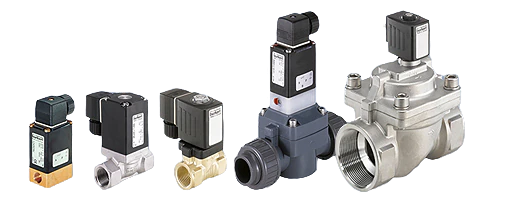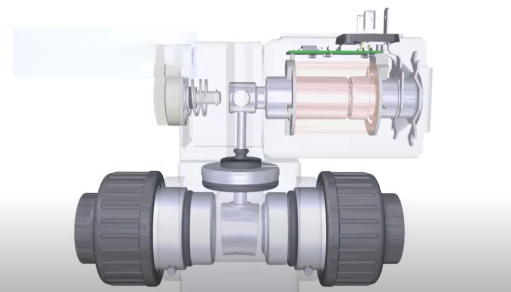Comprehensive Guide to Burkert Valve Error Codes
11.04.2024
Burkert valves, which offer exact control over fluid flow in a variety of operations, are essential parts of industrial settings. Burkert valves can, however, malfunction and make mistakes, just like any other complicated device. Understanding Burkert valve error codes is essential for diagnosing issues swiftly and ensuring uninterrupted operation.
By gaining a deeper understanding of Burkert valve error codes and implementing effective troubleshooting techniques, industrial professionals can minimize downtime, prevent costly repairs, and uphold safety standards.
What are Burkert valves?
Burkert valves are carefully made components used in a wide range of industrial applications to control the flow of gases and liquids. Burkert valves are widely used in many industries, including chemical processing, food and beverage processing, water treatment, and pharmaceuticals. They are well-known for their dependability, accuracy, and lifespan.
These valves are available in a range of varieties, each suited to the demands of a particular application, such as solenoid valves, pneumatic valves, proportional valves, and process valves. Burkert valves are essential for streamlining streams, combining materials, and controlling fluid flow in industrial operations.
The Importance of Understanding Error Codes
In any complex machinery, malfunctions and operational issues are inevitable. However, what sets Burkert valves apart is their built-in diagnostic capabilities, manifested through error codes. These codes are useful markers of possible problems in the valve system, allowing operators to quickly identify difficulties and take the necessary corrective action.
Common error codes in Burkert Solenoid valves
Like any complicated piece of machinery, burkett solenoid valves can have a number of error codes that point to underlying issues. For the purpose of identifying and resolving valve issues, the Burkert Solenoid Valve Error Code Chart is an invaluable tool. The most frequent error codes are shown in the table along with an explanation, potential causes, and workarounds.
| Error Code | Explanation | Cause | Solution |
| 2001 | Valve closing failed | - Residual pressure in the valve. | - Check and relieve pressure. |
| 2002 | Valve does not open | - Insufficient pressure in the valve. | - Check the pressure. |
| 2003 | Position sensor error | - Sensor malfunction. | - Check the sensor. |
| 2004 | Valve overheating | - Excessively high ambient temperature. | - Reduce the ambient temperature. |
| 2005 | Coil short circuit | - Coil damage. | - Replace the coil. |
| 2006 | Coil open circuit | - Coil damage. | - Replace the coil. |
| 2007 | Low supply voltage | - Insufficient supply voltage. | - Check the supply voltage. |
| 2008 | Overvoltage | - Excessive supply voltage. | - Check the supply voltage. |
| 3001 | Residual pressure in the valve | - Valve not fully closed. | - Check the valve. |
| 3002 | Insufficient pressure in the valve | - Low system pressure. | - Check the system pressure. |
| 3003 | Valve leakage | - Valve damage. | - Replace the valve. |
| 3004 | Pressure sensor error | - Sensor malfunction. | - Check the sensor. |
| 4001 | Communication error with the control module | - Communication cable damage. | - Check the cable. |
| 4002 | Incorrect configuration of the control module | - Incorrect configuration parameters. | - Check the configuration parameters. |
| 4003 | Control module software error | - Software malfunction. | - Update the software. |
| 5001 | General error | - Unknown cause. | - Contact the service center. |
| 5002 | Unknown error | - Unknown cause. | - Contact the service center. |

By following these troubleshooting tips and using the diagnostic capabilities of Burkert solenoid valve, you can effectively identify and resolve common error codes, ensuring reliable operation and minimizing downtime in industrial applications.
Typical Control Valve Error Code
Burkert control valves are dependable and high-quality equipment utilized in many different industrial settings. They may, however, occasionally malfunction, like any other mechanical equipment.
The table below describes the typical error codes that may occur in Burkert control valves
| Error Code | Description | Possible Causes | Troubleshooting Tips |
| E01 | Temperature too high | - High ambient temperature | - Check ambient temperature |
| E02 | Temperature too low | - Low ambient temperature | - Check ambient temperature |
| E03 | Pressure too high | - Excessive inlet pressure | - Check inlet pressure |
| E04 | Pressure too low | - Low inlet pressure | - Check inlet pressure |
| E05 | Sensor error | - Faulty valve position sensor | - Replace the sensor |
| E06 | Communication error | - Communication error with PLC | - Check the communication cable |
| E07 | Overheating | - Excessive coil temperature | - Check coil temperature |
| E08 | Short circuit | - Short circuit in the coil | - Replace coil |
Using the error code table and additional resources will allow you to quickly and efficiently troubleshoot Burkert control valves.
Burkert Pneumatic Valves Common Error Codes
Information on the error codes that occur most often in pneumatic valve will help you quickly determine the cause of the malfunction and take appropriate measures to eliminate it.
| Error Code | Description | Error Causes | Troubleshooting Tips |
| E01 | Sensor error | - Faulty valve position sensor | - Replace the sensor |
| E02 | Pressure too high | - Excessive inlet pressure | - Check inlet pressure |
| E03 | Pressure too low | - Low inlet pressure | - Check inlet pressure |
| E04 | Delay in operation | - Faulty valve | - Check the valve |
| E05 | Communication error | - Communication error with PLC | - Check the communication cable |
| E06 | Overheating | - Excessive coil temperature | - Check coil temperature |
| E07 | Short circuit | - Short circuit in the coil | - Replace coil |
To ensure dependable performance in industrial pneumatic, it is crucial to comprehend the frequent error codes associated with Burkert pneumatic valve and to diagnose and resolve problems in an efficient manner.
Troubleshooting tips for error codes
An industrial equipment expert, it is essential to understand Burkert valve error codes, effective troubleshooting tips and the importance of preventive maintenance. Understanding these codes is critical to timely intervention and preventing costly downtime.
When you encounter Burkert valve error codes, a systematic troubleshooting approach is paramount. Here are some tips for effectively solving common error codes:
- Consult your manual: For instructions on interpreting error codes and suggested troubleshooting methods, refer to the manufacturer's handbook.
- Visual Inspection: Look for any obvious indications of damage, leaks, or obstructions by visually inspecting the valve and any related parts.
- Checking electrical components: Use diagnostic tools to check the functionality of electrical components such as solenoid coils, sensors, and wire harnesses.
- Check Calibration: Check the calibration settings of the valve and related sensors, adjusting the necessary parameters to optimize performance.
- Monitor system performance: Continuously monitor valve system performance during operation by recording system parameters and identifying any anomalies.
The importance of preventive maintenance
Burkert valve longevity and efficiency are greatly increased by preventive maintenance. Frequent maintenance lowers the chance of unplanned downtime and expensive repairs by assisting in the early detection of possible issues. Industrial operators may guarantee Burkert valve dependability and optimal performance by putting in place a preventive maintenance strategy.

Basic preventive maintenance practices
Here are some basic preventative maintenance practices for Burkert valves:
- Regular Inspection: Visually inspect valves and associated parts on a regular basis to look for wear, damage, or corrosion.
- Lubrication: Ensure proper lubrication of moving parts to minimize friction and extend valve life.
- Cleaning: Periodically clean valves and associated components to remove debris, sediment, or contamination that could affect performance.
- Calibration Checks: Perform regular calibration checks to ensure the valve is operating accurately and within specified parameters.
- Training: Train personnel in proper valve maintenance procedures and safety protocols to prevent accidents and ensure efficient troubleshooting.
Conclusion
Understanding Burkert valve error codes is paramount for ensuring smooth industrial operations and safeguarding both production processes and personnel safety. By acting as early warning systems, these error codes inform operators of possible problems with the valve system. Ignoring or misinterpreting these codes can lead to disruptions in production, costly downtime, and even safety hazards.
Industrial personnel can limit production damage and avoid further issues by using efficient troubleshooting strategies to swiftly address erroneous codes. Prompt assistance not only helps Burkert valves operate again, but it also guards against equipment damage and guarantees the safety of nearby workers.
Furthermore, it is impossible to exaggerate the significance of preventive maintenance. Burkert valves can benefit from routine inspection, upkeep, and calibration to help detect and address concerns before they become more serious ones. This proactive strategy extends the life of valves and improves overall operational efficiency in addition to lowering the frequency of error code occurrences.
Burkert valve error codes must be quickly removed in today's fast-paced industrial environment, as downtime can cause serious financial losses and safety hazards. It gives industrial operators the ability to continue producing without interruption, streamline workflows, and enforce safety regulations.